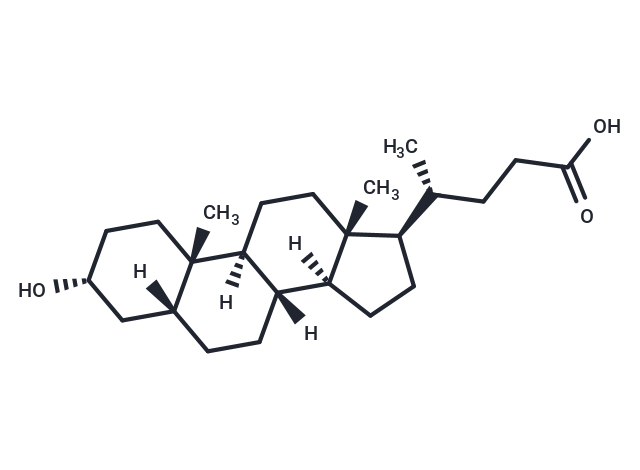Shopping Cart
Remove All Your shopping cart is currently empty
Your shopping cart is currently empty
Lithocholic acid (3α-Hydroxy-5β-cholanic acid) is a toxic secondary bile acid, They were FXR antagonists (IC50=0.7, 1.4 μM), EphA2 antagonists (IC50=48, 66 μM) and EphB4 antagonists (IC50=141 μM). Lithocholic acid can promote intrahepatic cholestasis and promote tumorigenesis. Lithocholic acid is a cleanser that dissolves fat for absorption and is itself absorbed.

| Pack Size | Price | USA Warehouse | Global Warehouse | Quantity |
|---|---|---|---|---|
| 500 mg | $29 | In Stock | In Stock | |
| 1 mL x 10 mM (in DMSO) | $29 | In Stock | In Stock |
| Description | Lithocholic acid (3α-Hydroxy-5β-cholanic acid) is a toxic secondary bile acid, They were FXR antagonists (IC50=0.7, 1.4 μM), EphA2 antagonists (IC50=48, 66 μM) and EphB4 antagonists (IC50=141 μM). Lithocholic acid can promote intrahepatic cholestasis and promote tumorigenesis. Lithocholic acid is a cleanser that dissolves fat for absorption and is itself absorbed. |
| Targets&IC50 | PC3 cells:32.0 µM, HCT116 cells (p53−/−):37.4 ± 3.8 μM (LD50), USP2a:31.1 ± 3.4 µM, DU-145 cells:30.4 µM, HCT116 cells (wt):46.8 ± 2.6 μM (LD50) |
| In vitro | METHODS: Human A549, HCT-116, HT-29, Huh-7, LoVo, MGC-803, RKO, SK-HEP1, SW480 cells were treated with Lithocholic acid (200, 100, 50, P < 0.05). 25, 12.5, 6.25, 3.125, 1.5625 μM) were used to detect the cell growth inhibition by MTT method. RESULTS: Lithocholic acid did not affect the growth of A549, HCT-116, HT-29, Huh-7, LoVo, MGC-803, RKO, SK-HEP1, and SW480 cells (IC50> 200 µM). [1] METHODS: Human Caco2 and HT-1080 cells were treated with Lithocholic acid (0.1-1000 μM) for 24 hours, and the cytotoxicity was detected by MTT assay. RESULTS: Lithocholic acid significantly inhibited the growth of Caco2 (IC50=56 μM) and HT-1080 cells (IC50=23 μM). [2] METHODS: Human DLD1, HCT-116, and HCT-8 cells were treated with Lithocholic acid (25, 50, 100, 150, and 200μM) for 48 hours, and the cytotoxicity was detected by MTT assay. RESULTS: Lithocholic acid significantly inhibited the growth of human DLD1 (IC50=173.1 μM), HCT-116 (IC50=81.1 μM) and HCT-8 (IC50=97.4 μM) cells. [3] |
| In vivo | METHODS: To investigate the antiviral effect of Lithocholic acid, Lithocholic acid oleate (3%) and Lithocholic acid (0.5%), derivatives of LCA, were administered to HSV-1 virus infected mice. RESULTS: Mice treated with Lithocholic acid oleate+Lithocholic acid 48 hours before virus inoculation showed lesions on day 6 after infection, and the wound healing was better than that of the acyclovir treatment group, with reduced scar formation and better skin repair. [4] |
| Kinase Assay | Competitive ligand binding assay.: Ligand binding is performed using lysates from COS-7 cells transfected with expression plasmids for VDR or RXRα. Binding is performed overnight at 4°C in lysate buffer with 0.71 nM (18 Ci/mmol) [3H]1,25(OH)2D3 and bile acid competitor. Unbound [3H]1,25(OH)2D3 is removed by adsorption to dextran-coated charcoal and the supernatant removed for scintillation counting. Ki values are calculated from a computer fit of competition curves from triplicate assays. |
| Synonyms | 3α-Hydroxy-5β-cholanic acid |
| Molecular Weight | 376.57 |
| Formula | C24H40O3 |
| Cas No. | 434-13-9 |
| Smiles | [H][C@@]12CC[C@H]([C@H](C)CCC(O)=O)[C@@]1(C)CC[C@@]1([H])[C@@]2([H])CC[C@]2([H])C[C@H](O)CC[C@]12C |
| Relative Density. | 1.0454 g/cm3 (Estimated) |
| Color | White |
| Appearance | Solid |
| Storage | keep away from moisture | Powder: -20°C for 3 years | In solvent: -80°C for 1 year | Shipping with blue ice/Shipping at ambient temperature. | |||||||||||||||||||||||||||||||||||
| Solubility Information | Ethanol: 44 mg/mL (116.84 mM), Sonication is recommended. DMSO: 49 mg/mL (130.12 mM), Sonication is recommended. H2O: < 1 mg/mL (insoluble or slightly soluble) | |||||||||||||||||||||||||||||||||||
Solution Preparation Table | ||||||||||||||||||||||||||||||||||||
Ethanol/DMSO
| ||||||||||||||||||||||||||||||||||||
| Size | Quantity | Unit Price | Amount | Operation |
|---|

Copyright © 2015-2025 TargetMol Chemicals Inc. All Rights Reserved.